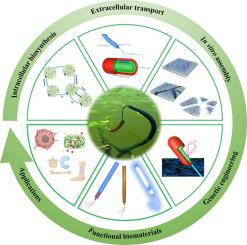Progress in Materials Science ( IF 33.6 ) Pub Date : 2022-06-01 , DOI: 10.1016/j.pmatsci.2022.100972 Sehrish Manan , Muhammad Wajid Ullah , Mazhar Ul-Islam , Zhijun Shi , Mario Gauthier , Guang Yang

|
Among the different types of nanocellulose being investigated, bacterial cellulose (BC) or bacterial nanocellulose (BNC) is receiving tremendous attention due to its purity and superior features. Either alone or in the form of composites, BC finds diverse applications in different fields. However, the low yield and productivity of BC by microbial cells and the high cost of the bioreactors and medium components, perhaps due to limited knowledge of its biosynthesis mechanism and extracellular transport in microbial cells, are major constraints to the industrial-scale production and commercial applications of BC and BC-based products. Molecular studies revealed the involvement of specific operons (bcsABCD) in the biosynthesis, extracellular transport, and in vitro supramolecular assembly of cellulose fibrils. The yield and productivity, as well as the innate structural and functional properties of BC, can be modulated through genetic and metabolic modeling, which requires comprehensive genetic knowledge obtained through genome sequencing of the BC-producing bacterial strains. Thanks to the latest developments in genetic engineering, various bacterial strains have been engineered via overexpression or the knockdown of target genes, not only to enhance the BC yield and productivity but also to improve its structural features such as the density, porosity, and mechanical strength of the fibers, as well as to achieve the in situ functionalization of BC for specific applications. This review describes the molecular aspects of the biosynthesis, regulation, and organization of cellulose nanofibrils into highly ordered structures by BC-producing bacterial cells. It further discusses the control of structural features of BC at the molecular level, both to improve its innate features and impart additional functional properties. Overall, this review aims to provide a platform for molecular biologists and material engineers to improve BC production and develop strategies for the in vivo development of BC-based hybrid materials with improved and novel features for various bio-oriented applications.
中文翻译:

细菌纤维素:生物合成的分子调控、超分子组装以及定制的结构和功能特性
在正在研究的不同类型的纳米纤维素中,细菌纤维素(BC)或细菌纳米纤维素(BNC)因其纯度和优越的特性而受到极大的关注。无论是单独使用还是以复合材料的形式,BC 在不同领域都有不同的应用。然而,微生物细胞对 BC 的低产量和生产力以及生物反应器和培养基成分的高成本,可能是由于对其生物合成机制和微生物细胞中细胞外运输的了解有限,是工业规模生产和商业化的主要限制因素。 BC 和基于 BC 的产品的应用。分子研究揭示了特定操纵子 ( bcsABCD ) 参与生物合成、细胞外转运和体外纤维素原纤维的超分子组装。BC 的产量和生产力以及先天的结构和功能特性可以通过遗传和代谢模型进行调节,这需要通过对产生 BC 的细菌菌株进行基因组测序获得全面的遗传知识。由于基因工程的最新发展,已经通过过表达或敲低靶基因对各种细菌菌株进行工程改造,不仅可以提高 BC 产量和生产力,还可以改善其结构特征,如密度、孔隙率和机械强度纤维,以及实现原位针对特定应用对 BC 进行功能化。这篇综述描述了生物合成、调控和将纤维素纳米原纤维组织成高度有序结构的分子方面,这些结构由产生 BC 的细菌细胞进行。它进一步讨论了在分子水平上对 BC 结构特征的控制,以改善其先天特征并赋予额外的功能特性。总体而言,本综述旨在为分子生物学家和材料工程师提供一个平台,以改善 BC 的生产,并为基于 BC 的杂化材料的体内开发制定策略,该材料具有改进的和新颖的特性,适用于各种面向生物的应用。









































 京公网安备 11010802027423号
京公网安备 11010802027423号